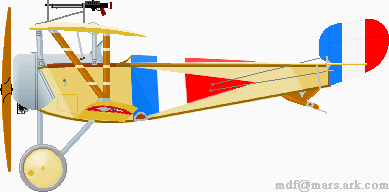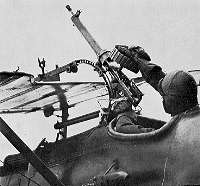

The small Nieuport 11 biplane was affectionately known as the "Bébé" (baby). Originally designed for racing, this light plane was fast and extremely maneuverable. Its only major problem was in the design of its wing struts. In a steep dive, the struts allowed the wings to twist, sometimes with disastrous results. Used by the British and French to counter the Fokker E.III, the Nieuport 11 was disadvantaged by its lack of a synchronized machine gun.

They were armed with a single Hotchkiss or Lewis machine gun mounted over the wing. Reloading of the gun was facilitated by the Foster gun mount, essentially a curved rail that the gun could be slid backwards and down so the pilot could reach the magazine on top of the machine gun. This was a difficult feat to perform under anything but calm flying conditions. With a variety of stops on the mount the gun could be inclined to fire upwards as well.
| Specifications |
| The Eleven's Role In THE RAZOR'S EDGE |
The NIEUPORT 11 played a small but significant role in substantiating the credibility of the Wanderling's Mentor (the same person W. Somerset Maugham used as Larry Darrell in his novel "The Razor's Edge"), as described below by the Wanderling writing about his Mentor:
"Another thing was his World War I adventures. He really didn't discuss it much except telling me that at age seventeen he was a fighter pilot flying for the British through Canada and that his best friend had died in front of his eyes. However, when I was growing up there was an 'old' man that tended the oil derricks not far from where I lived. While in high school I spent a good portion of every summer on my stepmother's ranch, but, even so, I remember at least once, possibly more, on the Fourth of July the 'old man' would take a bunch of us kids to the top of one of the old out of service wooden oil derricks scattered along the city line to watch the fireworks being shot off in the surrounding communities. He lived in a combination caretakers shack, repair shop near the wells. One day I took my mentor to his place just for the heck of it. On his wall were several framed photographs of biplanes with men standing around in front of them dressed in WW I flight regalia. Come to find out the oil well man had been a pilot fighting for the French in the
Lafayette Flying Corps and was one of the men in the photos. Next thing I knew my mentor and the oil well man were swaping war stories about everything from pulling thousand foot long Zeppelins out of the sky using Twin Vickers armed with tracers to R & R in Paris. My mentor flew Sopwith Camels, the oil well man Neiuport 11s. I learned more about WW I in those few hours than all my years in school."(source)
The Razor's Edge is a novel published in 1944 based on real life circumstances written by the renown British playwright and author William Somerset Maugham. The story takes place starting just after World War I through to the start of World War II and follows a young American Maugham calls Larry Darrell (the same person as the Wanderling's Mentor) as he searches for spiritual awakening. High in the mountains of India Darrell experiences Enlightenment. However, what drove him on his quest initially was seeing his best friend die in front of his eyes following a dogfight with the Germans. Darrell had gone to Canada, enlisted in the Canadian military at age sixteen and was flying through them for the British in France by 1917. His best friend was an Irishman called Patsy. Patsy taught him everything he needed to know and how to survive. Inturn, in the end, it was Patsy that Larry saw die...after saving his life. Although the type plane both Larry and Patsy flew is never mentioned in the novel, it is known they were Sopwith Camels. The following is Maugham's discription of what happened as he listens to Larry tell the story:
"The day we were to go on leave (to Paris) we were sent up to fly over the enemy lines and bring back reports of what we saw. Suddenly we came bang up against some German planes, and before we knew where we were we were in the middle of a dogfight. One of them came after me, but I got in first. I took a look to see if he was going to crash and then out of the corner of my eye I saw another plane on my tail. I dived to get away from him, but he was on to me like a flash and I thought I was done for; then I saw Patsy come down on him like a streak of lightning and give him all he'd got. They'd had enough and sheered off and we made for home. My machine had got pretty well knocked about and I only just made it. Patsy got in before me. When I got out of my plane they'd just got him out of his. He was lying on the ground and they were waiting for the ambulance to come up. When he saw me he grinned."
"I got the blighter who was on your tail," he said.
"What's the matter, Patsy?" I asked.
"Oh, it's nothing. He winged me."
"He was looking deathly white. Suddenly a strange look came over his face. It had just come to him that he was dying, and the possibility of death had never so much as crossed his mind. Before they could stop him he sat up and gave a laugh."
"Well I'm jiggered," he said.
"He fell back dead. He was twenty-two. He was going to marry a girl in Ireland after the war."
It should be noted that as a very young boy growing up one of the Wanderling's childhood heroes going into, during, and coming out of World War II, according to the hero's biography or background story written about him, was said to have been a pilot in World War I. So said, he piloted a Neiuport during all of his early adventures, although rather than a Neiuport 11, he flew the later, more sophisticated Neiuport 17. See:
CAPTAIN MIDNIGHT
ZEPPELIN
CLICK
HERE FOR
ENLIGHTENMENT
ON THE RAZOR'S
EDGE
SEE
ZEPPELINS: HIGH ALTITUDE WARSHIPS
LAFFAYETTE FLYING CORPS
SOPWITH CAMEL
FOO FIGHTERS
ROSWELL UFO
SEE ALSO:
Leonardo Da Vinci and His Flying Machines
Legend of the Giant Bird
THE BEST OF THE MAUGHAM BIOGRAPHIES:
- WILLIAM SOMERSET MAUGHAM
Good biography. Lots of Maugham graphics, from early childhood to late adult.
- W. SOMERSET MAUGHAM: A BIOGRAPHY
- MAUGHAM
- LITERARY AMBULANCE DRIVERS
Everybody knows Hemingway drove an ambulance during WWI, nobody knows Maugham did.
- THE ART COLLECTION OF W. SOMERSET MAUGHAM
SPIRITUAL GUIDES, GURUS, AND TEACHERS INFLUENTIAL IN DARRELL'S LIFE OTHER THAN THE MAHARSHI:
- SWAMI RAMDAS
- YASUTANI HAKUUN ROSHI
- FATHER ENSHEIM
Includes a section on the missing years of the Razor's Edge- KOSTI